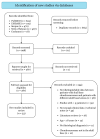Primary Skull Base Chondrosarcomas: A Systematic Review
- PMID: 34885071
- PMCID: PMC8656924
- DOI: 10.3390/cancers13235960
Primary Skull Base Chondrosarcomas: A Systematic Review
Abstract
Background: Primary skull base chondrosarcomas (SBCs) can severely affect patients' quality of life. Surgical-resection and radiotherapy are feasible but may cause debilitating complications. We systematically reviewed the literature on primary SBCs.
Methods: PubMed, EMBASE, Scopus, Web-of-Science, and Cochrane were searched following the PRISMA guidelines to include studies of patients with primary SBCs. Clinical characteristics, management strategies, and treatment outcomes were analyzed.
Results: We included 33 studies comprising 1307 patients. Primary SBCs mostly involved the middle-fossa (72.7%), infiltrating the cavernous-sinus in 42.4% of patients. Cranial-neuropathies were reported in 810 patients (62%). Surgical-resection (93.3%) was preferred over biopsy (6.6%). The most frequent open surgical approaches were frontotemporal-orbitozygomatic (17.6%) and pterional (11.9%), and 111 patients (21.3%) underwent endoscopic-endonasal resection. Post-surgical cerebrospinal-fluid leaks occurred in 36 patients (6.5%). Radiotherapy was delivered in 1018 patients (77.9%): photon-based (41.4%), proton-based (64.2%), and carbon-based (13.1%). Severe post-radiotherapy complications, mostly hypopituitarism (15.4%) and hearing loss (7.1%) were experienced by 251 patients (30.7%). Post-treatment symptom-improvement (46.7%) and reduced/stable tumor volumes (85.4%) showed no differences based on radiotherapy-protocols (p = 0.165; p = 0.062). Median follow-up was 67-months (range, 0.1-376). SBCs recurrences were reported in 211 cases (16.1%). The 5-year and 10-year progression-free survival rates were 84.3% and 67.4%, and overall survival rates were 94% and 84%.
Conclusion: Surgical-resection and radiotherapy are effective treatments in primary SBCs, with acceptable complication rates and favorable local tumor control.
Keywords: chondrosarcoma; endoscopy; radiation oncology; skull base oncology; systematic review.
Conflict of interest statement
The authors declare no conflict of interest.
Figures
References
Publication types
Grants and funding
LinkOut - more resources
Full Text Sources



